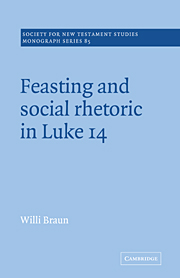Book contents
- Frontmatter
- Contents
- Acknowledgements and note on abbreviations
- 1 Introduction: how to read Luke 14?
- 2 Assumptions and preliminary reading
- 3 Jesus as a healer of craving desire (14.1–6)
- 4 Uncommon ‘symposium rules’ (14.7–11, 12–14)
- 5 The big dinner (14.15–24): aspects of Lukan performance
- 6 The conversion of a wealthy householder
- 7 Forms, genres and composition
- 8 Composition as argumentation: the rhetoric of Luke 14
- 9 Towards closure (and openings)
- Bibliography
- Indices
3 - Jesus as a healer of craving desire (14.1–6)
Published online by Cambridge University Press: 28 August 2009
- Frontmatter
- Contents
- Acknowledgements and note on abbreviations
- 1 Introduction: how to read Luke 14?
- 2 Assumptions and preliminary reading
- 3 Jesus as a healer of craving desire (14.1–6)
- 4 Uncommon ‘symposium rules’ (14.7–11, 12–14)
- 5 The big dinner (14.15–24): aspects of Lukan performance
- 6 The conversion of a wealthy householder
- 7 Forms, genres and composition
- 8 Composition as argumentation: the rhetoric of Luke 14
- 9 Towards closure (and openings)
- Bibliography
- Indices
Summary
Luke 14.1–6 is a single unit where 14.1 bears the double duty of introducing both the healing scene and the dinner episode as a whole. Several commentators consider 14.1 to be a complete sentence and so posit a division between 14.1 and 14.2 (e.g., Plummer, 1914, p. 354; Marshall, 1978, p. 578; RSV). This is doubtful. The entire first verse is merely the protasis; the apodosis begins with καὶ ἰδού (14.2) and not with καὶ αὐτοί (14.1b), a paratactic element of the protasis. As Fitzmyer points out, ‘unstressed kai autos functions in a special way in the kai egeneto construction in some instances. There Luke uses it to continue a paratactic, epexegetical description which is at times parallel to the temporal clause.’ Hence I would translate the first sentence thus: ‘And it happened, after he went into the house of a certain ruler of the Pharisees one sabbath to eat bread, and they were watching him, that (καί), behold, a certain man who had dropsy was before him.’
Despite the fact that this passage recounts a healing miracle it is not formally a miracle story. The therapeutic action is neither the focal point of the story nor important in itself.
- Type
- Chapter
- Information
- Feasting and Social Rhetoric in Luke 14 , pp. 22 - 42Publisher: Cambridge University PressPrint publication year: 1995



